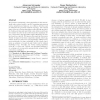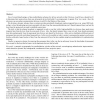101 search results - page 20 / 21 » An Adapting Random Walk for Ad Hoc and Sensor Networks |
SASN
2005
ACM
13 years 12 months ago
2005
ACM
Many emerging applications in both wired and wireless networks, such as information dissemination and distributed collaboration in an adversarial environment, need support of secu...
PODC
2009
ACM
14 years 6 months ago
2009
ACM
We present a randomized coloring algorithm for the unstructured radio network model, a model comprising autonomous nodes, asynchronous wake-up, no collision detection and an unkno...
MOBIHOC
2008
ACM
14 years 6 months ago
2008
ACM
Dealing with interference is one of the primary challenges to solve in the design of protocols for wireless ad-hoc networks. Most of the work in the literature assumes localized o...
SUTC
2008
IEEE
14 years 21 days ago
2008
IEEE
A piece of Hovering Information is a geo-localized information residing in a highly dynamic environment such as a mobile ad hoc network. This information is attached to a geograph...
ALGOSENSORS
2010
Springer
13 years 5 months ago
2010
Springer
One of crucial disadvantages of key predistribution schemes for ad hoc networks is that if devices A and B use a shared key K
to determine their session keys, then any adversarial...


